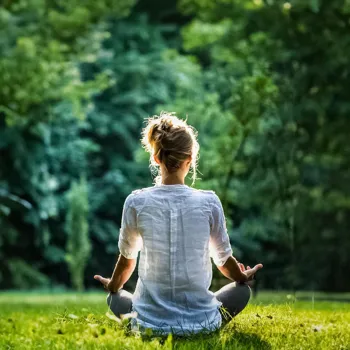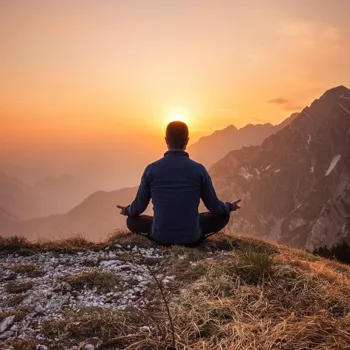Unlock the Secrets of Meditation: Discover 6 Techniques for Inner Peace! Ready to find calm in chaos? Explore now!
Namaste, readers! In today's fast-paced dunia, finding shanti – that elusive inner peace
– can feel like searching for a needle in a haystack. The constant buzz of notifications, the pressure of deadlines, and the never-ending to-do lists can leave us feeling frazzled and stressed.

But what if I told you there's a simple yet powerful tool to reclaim your inner calm? Meditation, an ancient practice rooted in Indian traditions, offers a pathway to navigate the storms of life with equanimity. It’s not about emptying your mind completely – that's practically impossible!
Instead, it's about training your attention, becoming more aware of your thoughts and feelings without getting carried away by them. Many folks think meditation is only for yogis in the Himalayas, but the truth is, anyone can incorporate it into their daily routine, no matter how busy.
Are you ready to discover the secrets to a more peaceful you? Let's explore six accessible meditation techniques that can help you unlock your inner peace.
Mindfulness meditation: focus on present moment without judgment, for mental exercise
One of the most accessible entry points to meditation is mindfulness meditation. It's all about paying attention to the present moment, without judgment. You can focus on your breath, the sensations in your body, the sounds around you, or even the taste of your food.

The key is to observe these experiences as they arise and pass, without getting caught up in thinking about them. Imagine sipping your morning chai – instead of rushing through it, take a moment to truly savour the aroma, the warmth, and the flavour. Notice how the cup feels in your hands.
As thoughts intrude, gently acknowledge them and redirect your attention back to your chosen focus. You can practice mindfulness meditation anywhere, anytime – while commuting, waiting in line, or even washing dishes.
Start with just a few minutes each day and gradually increase the duration as you become more comfortable. Remember, consistency is key. Don't be disheartened if your mind wanders – that's perfectly normal. The point is to keep coming back to the present moment, again and again.
It’s like doing exercise for your mind.
Guided meditation offers structure for beginners online or via apps, aiding relaxation
Next up is guided meditation. This technique is perfect for beginners, as it provides structure and direction. You can find countless guided meditation recordings online or through apps.

A guide will lead you through visualizations, affirmations, or stories, helping you to relax and focus your attention. Many guided meditations are themed, addressing specific concerns such as stress, anxiety, sleep, or self-esteem.
For instance, a guided meditation for anxiety might involve visualizing a peaceful scene, such as a beach or a forest, and focusing on the sensations of calmness and relaxation. The guide will often use calming language and soothing music to enhance the experience.
Guided meditations can be particularly helpful if you find it difficult to quiet your mind on your own. The external guidance provides a framework to anchor your attention and prevent your thoughts from spiralling. Experiment with different guides and themes to find what resonates with you.
It's like having a personal meditation coach in your pocket.
Practice body scan meditation for stress relief and relaxation
Thirdly, try body scan meditation. This involves systematically scanning your body from head to toe, paying attention to any sensations you feel. This technique helps you to become more aware of your physical body and to release tension. Lie down comfortably and close your eyes.
Start by focusing on your toes, noticing any sensations – tingling, warmth, or coolness. Then, gradually move your attention up your body, to your feet, ankles, calves, knees, thighs, hips, abdomen, chest, back, shoulders, arms, hands, neck, face, and head.
As you scan each body part, simply observe any sensations without judgment. If you notice tension, try to gently release it. You can also visualize the tension melting away. Body scan meditation can be particularly helpful for relieving stress and promoting relaxation.
It can also help you to connect with your body and to become more aware of its needs. By paying attention to your physical sensations, you can learn to recognize early signs of stress or discomfort and take steps to address them.
Walking meditation: mindful practice transforming daily stroll
Here we have walking meditation in the mix. This is a great option if you find it difficult to sit still for extended periods. Walking meditation involves paying attention to the sensations of walking – the feeling of your feet on the ground, the movement of your body, the rhythm of your breath.

Choose a quiet and safe place to walk, such as a park or a garden. Walk at a slow and deliberate pace, focusing on each step. Notice the feeling of your heel striking the ground, followed by your toes. Feel the weight shifting from one foot to the other.
Pay attention to the rhythm of your breath as you walk. As thoughts arise, gently acknowledge them and redirect your attention back to the sensations of walking. Walking meditation can be a great way to combine exercise with mindfulness.
It can also help you to appreciate the beauty of the natural world. By paying attention to the present moment, you can transform a mundane activity into a mindful practice. It's like turning your daily stroll into a moving meditation.
transcendental meditation involves mantra to quiet mind, reduce stress, improve focus
Next is Transcendental Meditation or TM. This technique involves the use of a mantra – a specific sound or word – to quiet the mind. TM is typically taught by a certified teacher, who will provide you with your personal mantra.

During meditation, you sit comfortably with your eyes closed and silently repeat your mantra. The mantra acts as an anchor for your attention, helping to quiet the chatter of your mind. As thoughts arise, gently acknowledge them and return your attention to the mantra.
TM is often practiced for 20 minutes twice a day. Many practitioners report that TM helps to reduce stress, improve focus, and promote overall well-being. It is a simple and effective technique that can be easily incorporated into your daily routine.
It’s like having a secret word that unlocks inner peace.
Practice loving-kindness meditation for inner peace and connection
Finally, try loving-kindness meditation. This practice involves cultivating feelings of love, compassion, and kindness towards yourself and others. Sit comfortably and close your eyes. Begin by directing feelings of love and kindness towards yourself.

Repeat phrases such as "May I be well, may I be happy, may I be peaceful, may I be free from suffering." Then, extend these feelings to someone you care about, such as a friend or family member. Repeat the same phrases, substituting their name for "I.
" Next, extend these feelings to someone neutral, such as a neighbour or colleague. Finally, extend these feelings to someone you find difficult or challenging. Loving-kindness meditation can help to cultivate empathy, compassion, and connection.
It can also help to reduce feelings of anger, resentment, and isolation. It's like sending out waves of positive energy into the world. So there you have it folks, six simple techniques to unearth that inner peace you have been searching for. Give them a try and let me know how it goes!
AI Generated Content. Glance/InMobi shall have no liability for the content









